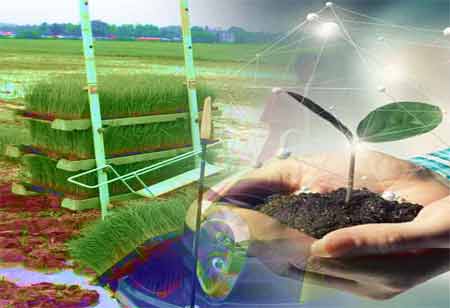Thank you for Subscribing to Agri Business Review Weekly Brief
Embracing Innovation for Sustainable Irrigation
Innovative technology has arisen to transform irrigation and water management practices as the globe struggles with the issues of water shortage and the need for sustainable agriculture.

By
Agri Business Review | Friday, June 09, 2023
Stay ahead of the industry with exclusive feature stories on the top companies, expert insights and the latest news delivered straight to your inbox. Subscribe today.
Innovative irrigation technologies enhance water-use efficiency, reduce consumption, and address environmental challenges. Government support and adoption can improve sustainability, crop yields, and agricultural development.
FREMONT, CA: Innovative technology has arisen to transform irrigation and water management practices as the globe struggles with the issues of water shortage and the need for sustainable agriculture. By enabling more efficient and effective use of water resources while maximising crop yields, these technologies are influencing both the present and the future of water management in agriculture. These developments are revolutionising how farmers and water management authorities approach irrigation, from sensor technology, satellite images, and artificial intelligence to drip irrigation, precision irrigation systems, and more.
Precision Irrigation Systems: The use of precision irrigation technology has revolutionised water management. These systems accurately distribute the necessary amount of water to plant roots by combining automation, data analytics, and smart sensors. Precision irrigation systems can drastically minimise water waste and raise overall water use efficiency by continuously monitoring soil moisture levels, weather, and plant water requirements. They give farmers the ability to customise irrigation schedules and volumes, which optimise crop growth and use less water.
Drip Irrigation: Although drip irrigation has been used for many years, technological advances have increased its effectiveness and accessibility. Through a system of tubes and emitters, water is directly delivered to the root zone of the plant using this technique. Drip irrigation ensures that water efficiently reaches the roots of the plants by reducing water loss due to evaporation and runoff. Additionally, it enables accurate management of water application rates, guaranteeing that each plant receives the proper dosage of water, nutrients, and oxygen. Since drip irrigation systems can conserve up to 50% more water than conventional irrigation techniques, they are very useful in areas with limited water resources.
Sensor Technology and Internet of Things (IoT): Irrigation management has been transformed by the Internet of Things (IoT) and sensor technology. Crop sensors, weather stations, and soil moisture sensors gather real-time information on a variety of environmental conditions. A central control system receives this data and analyses it to determine the precise irrigation needs. Farmers can remotely access this data via computers or cell phones, enabling them to make well-informed decisions regarding irrigation schedules and water allocation. Farmers may boost crop yields and lessen water loss by utilising IoT and sensor technology to monitor plant health, prevent over-irrigation, and optimise water use.
Remote Sensing and Satellite Imagery: Monitoring and maintaining extensive irrigation systems has shown to be greatly aided by remote sensing and satellite imaging. High-resolution photographs of agricultural fields can be taken by satellites with cutting-edge sensors, allowing for the detection of changes in vegetation health, soil moisture content, and water stress. Farmers and water management agencies can spot regions with inefficient water use, leaks, or potential crop diseases by analysing this data. With the use of these insights, corrective action may be taken right away to ensure ideal water management and minimise wasteful water loss.
Artificial Intelligence and Machine Learning: By enabling predictive forecasting and optimisation, artificial intelligence (AI) and machine learning (ML) algorithms are revolutionising irrigation water management. Large volumes of data, including past weather patterns, soil properties, crop varieties, and irrigation schedules, can be processed by these technologies. Consequently, AI and ML systems can produce precise forecasts and suggestions for the best irrigation plans. These tools assist farmers in making data-driven decisions, improving crop output and water use efficiency, by analysing complex correlations between variables.
AI in irrigation management provides valuable insights and predictions regarding water requirements, enabling farmers and water managers to make informed decisions, leading to optimised water distribution and reduced water wastage.
Micro-irrigation systems: offer precise water application directly to the root zone of plants, minimising water losses. They are adaptable to meet the specific water requirements of diverse crops, soil types, and field conditions, and have positive impacts on crop productivity and quality.
Robotic systems: these have the potential to revolutionise the way plant health is assessed, pests are detected, and water needs are determined. By continuously monitoring soil conditions and analysing plant data, they accurately determine the water requirements of crops.
The future of water management in irrigation holds immense potential for addressing water scarcity, climate change, and food security. Innovative technologies and practices are set to shape this future, such as smart irrigation systems, water recycling and reuse, precision agriculture, and climate-responsive irrigation. Smart irrigation systems will optimise water usage, minimise waste, and ensure precise delivery of water to crops, while water recycling and reuse will reduce reliance on freshwater sources and maximise water availability. Precision agriculture techniques will incorporate innovative technologies to enhance water management in irrigation. Climate-responsive irrigation systems will optimise water usage based on specific climatic conditions, ensuring efficient water management.
Innovative technologies in irrigation have revolutionised water management practices, both in the present and for the future. These technologies enable farmers to optimise water usage, reduce waste, and improve efficiency. Smart irrigation systems, powered by AI, ML, and IoT, will autonomously adapt to changing conditions, optimising water distribution in real-time. Precision agriculture techniques will evolve, leveraging remote sensing and drones. Climate-responsive irrigation practices will be crucial, and energy-efficient irrigation practices and renewable energy sources will be integrated. Collaboration among stakeholders and supportive policies are essential for the widespread adoption and implementation of these technologies.





